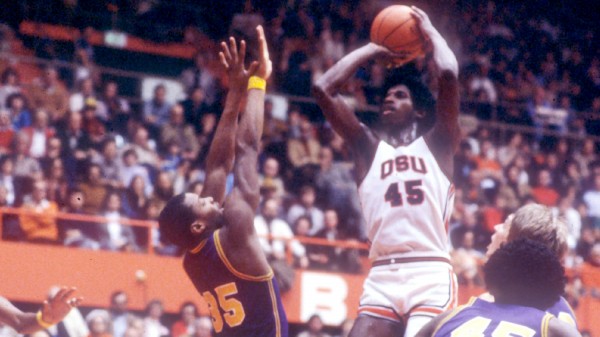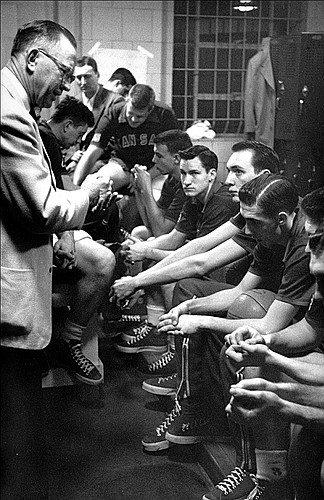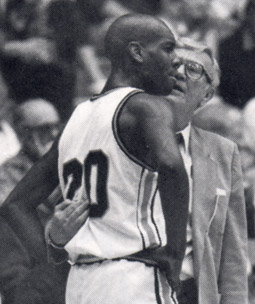The 2016 NCAA Tournament is a time to remember the life and career of Ralph Miller.
One of college basketball’s quietly great coaches — a Hall of Famer without a Final Four appearance — no longer walks the earth. Miller died in 2001 at the age of 82. However, if there is a heaven, you can be sure Miller will be smiling from his perch when one of his teams takes the floor in the round of 64.
Friday in Oklahoma City, the Oregon State Beavers return to the NCAA tournament for the first time since 1990. This year, the Beavers brought an end to the longest NCAA tournament drought among any Power 5 conference program which had made a previous appearance in the Dance. (Northwestern, obviously, is its own separate story, having never made the tournament.)
Jim Anderson was OSU’s coach in 1990, but he was in position to succeed that year because Miller set the table for him. Miller recruited Gary Payton from the streets of Oakland, bringing him to the sleepy town of Corvallis after St. John’s and Lou Carnesecca made the mammoth mistake of letting Payton go. (How much would THAT have changed the latter half of the 1980s in the Big East?!)
Miller built Oregon State into a winner in the 1980s. Casual sports fans of a certain age know of Payton, and they also know the name A.C. Green, who flourished under Miller’s guidance in the early half of the 1980s. Green was only a freshman in 1982, but during that season, the Beavers made their way into the Elite Eight before Georgetown stopped them one win short of the Final Four:
— The Comeback NCAA (@TheComebackNCAA) March 16, 2016
When Oregon State defeated Idaho (and future Oregon Duck head coach Don Monson) in the 1982 Sweet 16, two days before losing to Georgetown in the Elite Eight, neither Miller nor anyone else in Corvallis could have known that would become the last time the Beavers won an NCAA tournament game for the next third of a century. Indeed, it’s now been 34 years since Oregon State last won an NCAA game. This year’s team, under coach Wayne Tinkle, has already snapped a 26-year Dance drought. Now, the Beavers will try to advance in a bracket for the first time since 1982, when Oregon State basketball ruled the Pac-10 Conference.
Ralph Miller was the architect of the program, which capitalized on the instability at UCLA in the years following the retirement of John Wooden. It was only fitting that Miller would take advantage of the departure of one legend — not because he himself was a legend, but because he learned the game of basketball from its most towering early-period figures.
The photo to the left is one of the all-time great photos in college basketball history — not necessarily because of the artistic quality of the shot (though it rates as impressive), but because of two men in it.
On the far left, in jacket and tie, is Phog Allen, the iconic coach at the University of Kansas who learned the game from Dr. James Naismith, the father of basketball. In that photo, two faces to the left of the player wearing a “KANSAS” warm-up jacket, is Dean Smith, then a player for KU. The Jayhawks were preparing for their national championship game at the 1952 Final Four on the campus of the University of Washington in Seattle. Kansas defeated St. John’s to win the first of three titles. Smith carried the torch from Phog Allen, knitting together the whole of college basketball in and through the state of Kansas.
What Smith received from Allen, he took and gave to Larry Brown and Roy Williams. Brown won KU’s second national title in 1988, and Williams followed Brown in elevating the Jayhawks to a great height before coming home to North Carolina.
Other coaches learned at the foot of Phog Allen, spreading the gospel of basketball and giving added dimension to the growth of the sport in the 20th century.
Ralph Miller was one of these men.
When Allen, his mentor, was busy coaching Kansas to its first national crown, Miller had just concluded his first season as a major college head coach — also in the Sunflower State with the Wichita State Shockers. That first season — 1951-’52 — was a losing season for Miller. His first season with Oregon State — 1970-’71 — was also a losing campaign.
In a career which spanned 39 years — from 1951 until his retirement in 1989 at age 70 — Miller had only ONE losing season other than his initial journeys in Wichita and Corvallis. The native of Chanute, Kansas — who learned from the masters in a basketball-mad state — became one of college basketball’s most consistent winners. Miller’s steadiness — his ability to hardly ever suffer a “down” season once he got hold of his program — was his calling card. He never made the Final Four (like other great coaches such as John Chaney and Gene Keady), but he set an incredibly high standard nonetheless… strong enough that he was enshrined in the Naismith Basketball Hall of Fame before his career ended, in 1988.
The greatness of Miller’s career lies in the fact that he succeeded fabulously in three places which have not thrived with unrelenting annual regularity.
Wichita State enjoyed a very strong decade in the 1980s and has been similarly productive over the past decade under current coach Gregg Marshall. However, this is a program which went 18 years between NCAA tournament appearances (1988-2006) and had made the Big Dance only three times before 1981.
Ralph Miller led Wichita State to its first Elite Eight in 1964. When he left to take the Iowa job, he left his successor in good position to win big the next year… as would be the case at Oregon State, 25 years later.
In 1965, Wichita State made its first Final Four. The Shockers wouldn’t return to the promised land again until 2013, when Marshall worked his magic in the West Region against Gonzaga and later Ohio State. Miller didn’t get to bask in the glow of that moment — he was, as you can see, a Moses-like figure in his career — but he made Wichita State’s ascendancy possible. He’s one of only four men to take the Shockers to the Elite Eight.
That would become a theme of his career: one of a very few to do something great at a school which doesn’t enjoy annual basketball greatness.
Iowa hasn’t made the Sweet 16 this century, and it hasn’t reached the Elite Eight since 1987. The Hawkeyes have been to the Elite Eight only four times, and only twice since 1956. This is not a program which easily reloads and stays at the top of the mountain in college hoops.
Ralph Miller became one of only four men to take Iowa to the Sweet 16. His feat in 1970 enabled him to join Bucky O’Connor and two future authors of that same accomplishment, Lute Olson and Dr. Tom Davis.

A.C. Green was on the last Oregon State team to win an NCAA tournament game, in 1982. Of all the Power 5 teams participating in this year’s tournament, Oregon State’s drought of 34 years since its last NCAA win is the longest.
When he had improved Iowa, Miller then took over at Oregon State in 1970. It’s true that Oregon State had been carried to a place of prominence by the school’s most successful coach, Slats Gill. Oregon State made two Final Fours and four Elite Eights under Gill, who stepped down in 1964 one year after a Final Four appearance and after 35 seasons on the job. Paul Valenti succeeded Gill, and in the short run, he made use of the resources entrusted to him. The 1966 team reached another Elite Eight, and it appeared that Oregon State would continue to remain a player in Western college basketball.
However, just when Valenti had seemingly sustained what Gill had given him, the bottom fell out. From 1967 through 1970, the Beavers failed to produce a single winning season.
Miller — who had improved Wichita State and Iowa over time — was just the man to revive Oregon State as well. After that first losing season in 1971, Miller didn’t have another losing campaign until 1986, and that was quickly followed by a climb back to the NCAA tournament in 1988 and — in his last go-round — 1989. He is, even today, one of only three men to lead Oregon State to the Elite Eight.
Miller — literally — was a rare coach at Wichita State, Iowa, and Oregon State. He was one of just three or four men to lead each of those programs to a particularly prominent place in the NCAA tournament and college basketball.
*
The most remembered and revered coaches are those who win national championships and make Final Fours. Ralph Miller never reached that pinnacle. Like a number of contemporaries — think of Ray Meyer at DePaul and Lefty Driesell at Maryland — March was a constant thorn in Miller’s side. He simply couldn’t break through in the postseason.
He was just ridiculously consistent at getting there.
In subsequent years, the folks at Oregon State and DePaul have realized how hard it is to maintain a program. While DePaul flounders, Oregon State finally seems to have found its new architect for the future in Wayne Tinkle. It took merely a quarter of a century to restore what Ralph Miller built.
He isn’t a giant figure in the public memory. He’s not a towering presence in the most popular history of college basketball. You won’t find him in the easy retrospectives always shown on television this time of year, every year.
Yet, Ralph Miller carved out a remarkable legacy over 38 years.
Time spent at the foot of Phog Allen, learning the game from one of its most authoritative sources, certainly enriched the sport of college basketball.
When Oregon State takes the floor on Friday against VCU, you will almost surely hear the name Ralph Miller. Now you’ll have a greater sense of what that man has meant to OSU basketball… and to college hoops as a whole.



